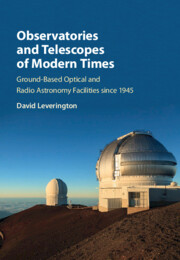 Observatories and Telescopes of Modern Times
Observatories and Telescopes of Modern Times from Part 2 - Radio Observatories
Published online by Cambridge University Press: 15 December 2016
Stockert Observatory and the Effelsberg Radio Telescope
Germany was excluded from the development of radio astronomy in the crucial years immediately after the end of the Second World War as restrictions on radio research were not lifted until 1950. But even then there were still many more important calls on state funding to rebuild the country after the war. So there was no sudden explosion of radio astronomy research in Germany in the early 1950s to match that already underway in Australia, the UK and elsewhere.
But starting in 1952 Friedrich Becker and H. Strahl gave a number of lectures about radio astronomy in local government ministries in Düsseldorf, the state capital of Nordrhein-Westfalen.(1) This resulted in the idea of building a 25 m diameter fully steerable radio telescope which could also be used for radar research. Design studies were carried out by Metallwerk Friedrichshafen and Telefunken who had built the German Würzburg radar antennae during the war. Enthusiastic backing for the proposed project came from Telefunken's former chief engineer Leo Brandt who was then Secretary of State in the Ministry of Economics and Traffic in Nordrhein-Westfalen. With his support 1.2 million DM (about $300,000) was raised to pay for the project which was undertaken by a consortium of companies headed by Telefunken.
The basic requirement of this 25 m radio telescope was that it should be able to detect radio emissions at the 21 cm wavelength (1.4 GHz) of neutral hydrogen and shorter if possible. This meant that its dish should have a surface accurate to about ±5 mm. It was also expected that the dish, which would be supported by an altazimuth mount, would be pointed to an accuracy of 1 arcminute. Naturally, considering the pedigree of the main contractors involved, the actual design was based on that of the Second World War 7.5 m diameter Würzburg radar antennae. The surface panels were of 2 mm thick sheet aluminium with 10 mm square perforations to reduce wind resistence. As far as location of the telescope was concerned, its use for radar research required it to be built with a good view of the horizon.
To save this book to your Kindle, first ensure [email protected] is added to your Approved Personal Document E-mail List under your Personal Document Settings on the Manage Your Content and Devices page of your Amazon account. Then enter the ‘name’ part of your Kindle email address below. Find out more about saving to your Kindle.
Note you can select to save to either the @free.kindle.com or @kindle.com variations. ‘@free.kindle.com’ emails are free but can only be saved to your device when it is connected to wi-fi. ‘@kindle.com’ emails can be delivered even when you are not connected to wi-fi, but note that service fees apply.
Find out more about the Kindle Personal Document Service.
To save content items to your account, please confirm that you agree to abide by our usage policies. If this is the first time you use this feature, you will be asked to authorise Cambridge Core to connect with your account. Find out more about saving content to Dropbox.
To save content items to your account, please confirm that you agree to abide by our usage policies. If this is the first time you use this feature, you will be asked to authorise Cambridge Core to connect with your account. Find out more about saving content to Google Drive.